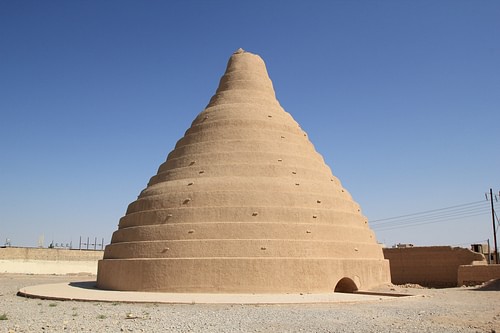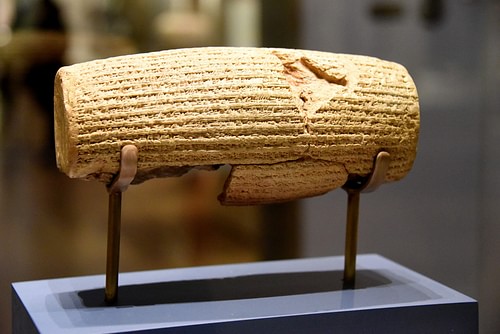Ancient Persian culture contributed many of the aspects of the modern world which people take for granted as having always existed. The designation “Persia” comes from the Greeks – primarily from the historian Herodotus – but the people of Persis (Pars, modern-day Fars) referred to themselves as Iranians, from Aryan, meaning “noble” or “free” and having nothing to do with race.
While that is understood, any reference to ancient Iranian culture – in the West at least – continues to be called “Persian” as that is the legacy left by the Greek writers.
The Persians established an empire which stretched from modern-day Turkey to India, up through Syria and down through Egypt and, further, invented and maintained amenities, policies, practices, institutions, and aspects of religion which are well-known – but not often properly attributed – in the present day. Among these are:
- First Declaration of Human Rights
- Irrigation and Refrigeration
- Landscaped Gardens and the Word 'Paradise'
- Birthday Celebrations, Animation, the Guitar, and Dessert
- Monotheism
- Elite Military Units and Uniforms
- Windmills and Air Conditioning
- Postal System and the Highway
- The Teaching Hospital
- Heavily Armored Cavalry
While these contributions may be understood as commonplace in the present day, they were entirely novel in their time. Although there were gardens in other cultures, and monotheism had been suggested by the Egyptian pharaoh Akhenaten (r. 1353-1336 BCE)) centuries before, the Persians were the first to develop these concepts fully.
First Declaration of Human Rights
The Cyrus Cylinder is a clay canister-shaped artifact inscribed with cuneiform script issued by Cyrus II (the Great, r. c. 550-530 BCE) c. 539 BCE. It is an official document that tells of Cyrus the Great's conquest of the various regions which made up the Achaemenid Empire (c. 550-330 BCE) and how they had embraced his rule. He then speaks of how he elevated the lives of the people through the rights and liberties granted them. This document has long been (and continues to be) understood as royal propaganda establishing a monarch's grandeur but, since 1971 CE, it has been increasingly recognized as the first declaration of human rights in the world. The Achaemenid Empire granted its citizens freedom of religious thought and practice as well as many other liberties denied those of other cultures, including almost equal rights for women.
Irrigation & Refrigeration
The concepts of irrigation and refrigeration are also often attributed to Cyrus the Great but, actually, were invented by earlier Persian innovators and are attested during the time of the Assyrian king Sargon II (r. 722-705 BCE). The qanat system – by which a sloping channel is dug into the earth with vertical shafts at intervals drawing water up from underground aquafers – served to irrigate otherwise arid lands and turned them into lush landscapes. The qanat system watered farm fields and allowed for the cultivation of elaborate gardens. The yakhchal was a domed refrigeration unit made of clay which was used to store ice but, in time, was also utilized to keep food cold.
Landscaped Gardens & the Word 'Paradise'
The qanat enabled the cultivation of landscaped gardens which became a regular feature of Persian architectural design. Cyrus the Great is said to have spent as much time in his gardens as possible before attending to the business of running his empire. These gardens were lush oases from daily life where one could relax and be alone with one's thoughts or enjoy the company of others and were known as pairi-daeza which gives English its word paradise.
Birthday Celebrations, Animation, the Guitar, and Dessert
The Persians were also the first to develop the practice of lavish celebrations of one's birthday as well as the art of animation for entertainment and the custom of having dessert after a meal. Birthday celebrations originated (as they did in other cultures) with a festival honoring the monarch's birth but gradually spread to members of the nobility and then the lower classes. In ancient Persia, birthdays were celebrated with special foods the guest of honor would enjoy and a cake for dessert with candles. Entertainment might have included animation – as evidenced by artifacts such as a cup which, when rapidly turned, showed a goat leaping in the air to snatch leaves from a tree – and music featuring vocals accompanied by stringed instruments such as the cartar (also known as the tar) and the sestar, precursor of the modern-day guitar. The practice of serving dessert after a meal was not reserved only for birthdays but followed every day's evening meal.
Monotheism
Monotheism was first introduced in Egypt under the reign of Akhenaten, and some scholars and writers (among them Sigmund Freud) have advanced the claim that Moses was influenced by Akhenaten's religion or may even have been one of his priests. However that may be, the Persian monotheistic religion of Zoroastrianism was founded c. 1500-1000 BCE by the prophet Zoroaster and was fully developed by the time early Judaism began to take shape (6th century BCE - 70 CE). Zoroastrianism held there was only one supreme being, Ahura Mazda, and the purpose of one's life was to follow the will of the benevolent God through the principles of Good Thoughts, Good Words, and Good Deeds. Zoroastrianism also was the first faith to fully develop the concepts of heaven, hell, and purgatory.
Elite Military Units & Uniforms
The Median king Cyaxares (r. 625-585 BCE) was the first in the region to divide his military into regiments and units (infantry, archers, cavalry) but Cyrus the Great, who conquered Media, reformed the earlier model, organizing the military on the decimal system where each unit was comprised of ten lesser units: 10 men = a company; 10 companies = a battalion; 10 battalions = a division; 10 divisions = a corps. Different units were identified by different colored uniforms (purple, yellow, blue). They also developed the concept of the elite military unit: the famous 10,000 Persian Immortals of the Achaemenid Empire and the Savaran Knights under the Sassanian Empire (224-651 CE).
Windmills & Air Conditioning
The Persians invented the windmill c. 500 CE, although, it should be noted, this is the first recorded mention and the devices were probably in use earlier. Windmills were used in pumping water and grinding grain. They were made of reeds woven together into paddles which were then fixed to a central axis. The concept was almost certainly suggested by the use of the sail on ships, but the Persians were already making use of wind on land through the ventilation system known as the windcatcher (wind tower), a structure attached to the top of a building which drew cool air down, pushing warmer air up and out. Scholars continue to debate whether the Persians or the Egyptians were the first to develop the windcatcher, but the evidence seems to favor the Persians, pre-dating the Achaemenid Period.
Postal System & the Highway
The postal system and concept of the highway were also developed by the Persians. Darius I (the Great, r. 522-486 BCE) instituted the Persian network of roads for speed of travel and contact between his capital cities (Babylon, Ecbatana, Persepolis, and Susa). The highways were then used to send messages between these cities as well as others, thus creating the postal system. The unofficial motto of the United States Postal Service – Neither snow, nor rain, nor gloom of night stays these couriers from the swift completion of their appointed rounds – inscribed on the New York City Post Office in 1914 CE (now known as the James A. Farley Building) comes from Herodotus' description of the Persian messenger system: “Whatever the conditions – it may be snowing, raining, blazing hot, or dark – they never fail to complete their assigned journey in the fastest possible time” (Histories, VIII.98). This highway system and postal service would continue to be used by the Seleucid Empire (312-63 BCE), the Parthian Empire (247 BCE-224 CE), the Sassanians, and the Muslim Arabs.
The Teaching Hospital
Under the reign of Shapur I (240-270 CE), the Academy of Gundeshapur was founded, quickly becoming the major intellectual and cultural center of the region. It is now thought its founding was inspired by Shapur I's principal wife, Azadokht Shahbanu, who first brought Greek physicians to the Imperial Court at Ctesiphon to establish a hospital. Under the later monarch Kosrau I (r. 531-579 CE), Gundeshapur flourished as the first teaching hospital in the world where young doctors-in-training worked under the supervision of more experienced physicians.
Heavily Armored Cavalry
The Parthians were the first to develop the concept of heavily armored cavalry in response to the arms and armor of their Greek and Roman adversaries. The Parthian cataphract wore a steel helmet and chain mail tunic which covered them from their necks to past their knees and down their arms and their horses were equally protected. Cataphracts carried composite bows, swords, daggers, and lances. This concept was further developed by the Sassanians to create their elite force of armored cavalry, the Savaran Knights, among the greatest fighting forces of the ancient world.
Conclusion
The Persians are responsible for many more inventions, innovations, and customs than only these, of course, including the Persian rug, the banquet, and popularizing tea as a daily drink. Cyrus the Great was the first to reform the tax system so that taxes were paid to the empire's treasury, not to the monarch, and were then used to pay for public works. Darius I dug the precursor to the Suez Canal, and his successor, Xerxes I (r. 486-465 BCE), created the longest “pontoon bridge” across the Hellespont for his 480 BCE invasion of Greece.
Herodotus notes that “the Persians adopt more foreign customs than anyone else” (I.135) and this is exemplified in the Persian talent for embracing new ideas and concepts and making them their own. Hospitals were already established in ancient Egypt during the time of the Old Kingdom (c. 2613-2181 BCE) but the Sassanians – whose empire is famous for their innovations on past models – took that concept further in the form of the teaching hospital which was also a library and center for learning. The Persian polymath Avicenna (l. c. 980-1037 CE) developed earlier medical knowledge to a much higher level, the poet Ferdowsi (l. c. 940-1020 CE) expanded the concept of the literary epic, and the mathematician Al-Khwarizmi (l. c. 780 - c. 850 CE) took earlier mathematical principles and invented algebra.
Many of the most recognizable concepts, customs, and inventions in the modern-day – if their origins are considered at all – are incorrectly attributed to the Greeks who wrote about them or later Muslim Arabs who did the same. Actually, however, all of the above – and more – came from the Persian capacity for imagination; to see what was and envision how it could be better.









